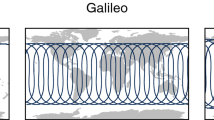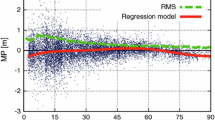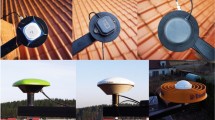Abstract
Precise navigation and geodetic coordinate determination rely on accurate GNSS signal reception. Thus, the receiver antenna properties play a crucial role in the GNSS error budget. For carrier phase observations, a spherical radiation pattern represents an ideal receiver antenna behaviour. Deviations are known as phase centre corrections. Due to synergy of carrier and code phase, similar effects on the code exist named code phase variations (CPV). They are mainly attributed to electromagnetic interactions of several active and passive elements of the receiver antenna. Consequently, a calibration and estimation strategy is necessary to determine the shape and magnitudes of the CPV. Such a concept was proposed, implemented and tested at the Institut für Erdmessung. The applied methodology and the obtained results are reported and discussed in this paper. We show that the azimuthal and elevation-dependent CPV can reach maximum magnitudes of 0.2–0.3 m for geodetic antennas and up to maximum values of 1.8 m for small navigation antennas. The obtained values are validated by dedicated tests in the observation and coordinate domain. As a result, CPV are identified to be antenna- related properties that are independent from location and time of calibration. Even for geodetic antennas when forming linear combinations the CPV effect can be amplified to values of 0.4–0.6 m. Thus, a significant fractional of the Melbourne–Wübbena linear combination. A case study highlights that incorrect ambiguity resolution can occur due to neglecting CPV corrections. The impact on the coordinates which may reach up to the dm level is illustrated.









Similar content being viewed by others
References
Aerts W (2011) Comparison of UniBonn and Geo++\({}^{\textregistered }\) calibration for LEIAR25.R3 antenna 09300021. Technical report, Royal Observatory of Belgium
Aerts W, Baire Q, Bilich A, Bruyninx C, Legrand J (2013) On the error sources in absolute individual antenna calibrations. In: Geophysical research abstracts, EGU2013-6113, vol 15. EGU General Assembly 2013, Vienna
Aerts W, Moore M (2013) Comparison of UniBonn and IGS08 antenna type means. In: White paper, International GNSS Service—Antenna Working Group IGS-AWG. EMail: IGS-AWG-393. ftp://ftp.sirgas.org/pub/igs/AntennaComparisons-Merged_final.pdf
Altamimi Z, Rebischung P, Métivier L, Collilieux X (2016) ITRF2014: a new release of the International Terrestrial Reference Frame modelling nonlinear station motions. J Geophys Res. doi:10.1002/2016JB013098
Böder V, Menge F, Seeber G, Wübbena G, Schmitz M (2001) How to deal with station dependent errors, new developments of the absolute field calibration of PCV and phase-multipath with a precise robot. In: Proceedings of the 14th international technical meeting of the satellite division of the institute of navigation (ION GPS 2001), September 11–14, Salt Lake City, UT, USA. Institute of Navigation (ION), pp 2166–2176
Defraigne P, Petit G (2003) Time transfer to TAI using geodetic receivers. Metrologia 40(4):184–188. doi:10.1088/0026-1394/40/4/307
Dong W, Jackson DR, Williams JT, Basilio LI (2006) Phase and group delays for circularly-polarized microstrip antennas. In: Proceedings of antennas and propagation society international symposium, July 9–14, Albuquerque, NM, USA. IEEE, pp 1537–1540. doi:10.1109/APS.2006.1710847
Engheta N, Ziolkowski RW (eds) (2006) Metamaterials: physics and engineering explorations. Wiley-IEEE Press, Piscataway
Fillipov V, Tatarnikov D, Ashjaee J, Astakhov A, Sutiagin I (1998) The first dual depth frequency choke ring antenna. In: Proceedings of the 11th international technical meeting of the satellite division of the institute of navigation (ION GPS 1998), September 15–18, Nashville, TN, USA Institute of Navigation (ION), pp 1035–1040
Geiger A (1988) Modelling of phase centre variation and its influence on GPS-positioning. In: Groten E, Strauss R (eds) GPS-techniques applied to geodesy and surveying, Lecture notes in earth sciences, vol 19 of proceedings of the international GPS-workshop Darmstadt, April 10–13, 1988. Springer, Berlin, pp 210–222. doi:10.1007/BFb0011339
Görres B, Campbell J, Becker M, Siems M (2006) Absolute calibration of GPS antennas: laboratory results and comparison with field and robot techniques. GPS Solut 10(2):136–145. doi:10.1007/s10291-005-0015-3
Gurtner W, Estey L (2013) RINEX The receiver independent exchange format. IGS publications. ftp://igs.org/pub/data/format/rinex302.pdf
Haines B, Bertiger W, Desai S, Harvey N, Sibois A, Weiss J (2012) Characterizing the GPS satellite antenna phase- and group-delay variations using data from low-earth orbiters. In: IGS Workshop 2012, University of Warmia and Mazury, Olsztyn, Poland, 23–27 July
Hatch R (1982). The synergism of GPS code and carrier measurements. In Peat RP, (ed) Proceedings of the third international geodetic symposium on satellite doppler positioning, vol 2. Defense Mapping Agency and National Ocean Survey, Las Cruces, NM, USA, pp 1213–1231, 8–12 Feb
Hobson E (1931) The theory of spherical and ellipsoidal harmonics. University Press, Cambridge
Hofmann-Wellenhof B, Moritz H (2006) Physical geodesy. Springer, Berlin
Huang Y, Boyle K (2008) Antennas—from theory to practice. Wiley, Chichester
IGS (2016a). International GNSS Service: details and naming conventions for IGS equipment—rcvr_ant.tab. electronic. ftp://igs.org/pub/station/general/rcvr_ant.tab
IGS (2016b). International GNSS Service: graphical receiver antenna reference point—(ARP) Definition—antenna.gra. electronic. ftp://igs.org/pub/station/antenna.gra
Kaniuth K, Stuber K (2002) The impact of antenna radomes on height estimates in regional GPS networks. In: Drewes H, Dodson AH, Fortes LPS, Sànchez L, Sandoval P (eds) International association of geodesy symposia on vertical reference systems, vol 124. Berlin, Springer, pp 101–106
Kaplan ED (ed) (1996) Understanding GPS—principles and applications. Artech House Inc, Norwood
Kersten T (2014) Bestimmung von Codephasen-Variationen bei GNSS-Empfangsantennen und deren Einfluss auf die Positionierung, Navigation und Zeitübertragung. Ph.D. thesis, Deutsche Geodätische Kommission (DGK) bei der Bayerischen Akademie der Wissenschaften (BADW), no. 740
Kersten T, Schön, S (2010) Towards modeling phase center variations for multi-frequency and multi-GNSS. In: 5th ESA workshop on satellite navigation technologies and european workshop on GNSS signals and signal processing (ESA Navitec), pp 1–8. doi:10.1109/NAVITEC.2010.5708040
Kersten T, Schön S (2011) GNSS group delay variations—potential for improving GNSS based time and frequency transfer? In: Proceedings of the 43rd annual precise time and time interval (PTTI) meeting. Long Beach, CA, pp 255–270
Kersten T, Schön S (2012) Von der Komponentenkalibrierung zur Systemanalyse: Konsistente Korrekturverfahren von Instrumentenfehlern für Multi-GNSS— Schlussbericht zum BMBF/DLR Vorhaben 50NA0903. Institut für Erdmessung, p 105
Kersten T, Schön S, Weinbach U (2012) On the impact of group delay variations on GNSS time and frequency transfer. In: Proceedings of the 26th European frequency and time forum (EFTF), 24–26 April 2012, Gothenborg, Sweden, pp 514–521. doi:10.1109/EFTF.2012.6502435
Kim U-S (2005) Analysis of carrier phase and group delay biases introduced by CRPA hardware. In: Proceedings of the international technical meeting of the satellite division of the institute of navigation (ION-GNSS), 13–16 Sep 2005, Long Beach, CA, USA. Institute of Navigation (ION), pp 635–642
Kouba J (2004) Improved relativistic transformations in GPS. GPS Solut 8(4):170–180. doi:10.1007/s10291-004-0102-x
Kouba J (2009) A guide to using international GNSS service (IGS) products. IGS Publications. http://acc.igs.org/UsingIGSProductsVer21.pdf
Kube F, Schön S, Feuerle T (2012) GNSS-based curved landing approaches with a virtual receiver. In: Proceedings of the position location and navigation symposium (ION-PLANS), 2012 IEEE/ION, 23–26 April, SC, USA. Institute of Navigation (ION), pp 188–196
Kunysz W (1998) Effect of antenna performance on the GPS signal accuracy. In: 11th international technical meeting of the satellite division of the institute of navigation (ION) GPS98, 15–18 Sep 1998, Nashville, TN, USA. Institute of Navigation (ION), pp 575–580
Kunysz W (2000) High performance GPS pinwheel antenna. In: Proceedings of the 2000 international technical meeting of the satellite division of the institute of navigation (ION GPS 2000), 19–22 Sep, Salt lake City, Utha USA. ION
Kunysz W (2003). A three dimensional choke ring ground plane antenna. In: Proceedings of the 16th international technical meeting of the satellite division of the institute of navigation (ION GPS/GNSS 2003), 9–12 Sep, Portland, OR, USA. Institute of Navigation (ION), pp 1883–1888
Mader G (1999) GPS antenna calibration at the National Geodetic Survey. GPS Solut 3(1):50–58. doi:10.1007/PL00012780
Mader GL, MacKay JR (1996) Calibration of GPS antennas. In: Neilan R, Scoy PV, Zumberge J (eds) Proceedings of the IGS analysis center workshop, Silver Spring, MD. JPL Publication 96-26, Jet Propulsion Laboratory, Pasadena, CA
Melbourne, WG (1985) The case for ranging in GPS-based geodetic systems. In: Goad CC (ed) Proceedings of the first international symposium on precise positioning with the global positioning system, Rockville, MD, 15–19 Apr
Menge F, Schmitz M (2001) Format and Geo++\({}^{\textregistered }\) convention for PCV antenna files. Manual. https://www.ife.uni-hannover.de/pcv_ant-format.html and http://www.geopp.com/media/docs/AOA_DM_T/format.html
Murphy T, Geren P, Pankaskie T (2007) GPS antenna group delay variation induced errors in a GNSS based precision approach and landing systems. In: Proceedings of the 20th international technical meeting of the satellite division of the institute of navigation (ION GNSS 2007), 25–28 Sep, Fort Worth, TX, USA. Institute of Navigation (ION), pp 2974–2989
Petrovski IG, Tsujii T (2012) Digital satellite navigation and geophysics. Cambridge University Press, Cambridge
Popugaev A, Wansch R (2009) A novel miniaturization technique in microstrip feed network design. In: Proceedings of European conference on antennas and propagation (EuCAP), 23–27 March 2009, Berlin, Germany, pp 2309–2313
Rao BR, Kunysz W, Fante RL, McDonals K (2013) GPS/GNSS antennas. Artech House Publishers, Norwood
Ray J, Senior K (2003) IGS/BIPM pilot project: GPS carrier phase for time/frequency transfer and timescale formation. Metrologia 40:270–288
Ray J, Senior K (2005) Geodetic techniques for time and frequency comparisons using GPS phase and code measurements. Metrologia 42(4):215–232. doi:10.1088/0026-1394/42/005
Rothacher M, Schmid R (2010) ANTEX: the antenna exchange format, Version 1.4. ftp://igscb.jpl.nasa.gov/igscb/station/general/antex14.txt
RTCA (2006). Minimum operational performance standards for global navigation satellite system (GNSS) airborne active antenna equipment for the L1 frequency band. RTCA/DO-301 Inc. Washington DC, Issued 13 Dec 2006
Schmid R (2013) Uncertainty of GNSS antenna phase center corrections. In: IERS workshop on Local Surveys and Co-locations, 22 May, Paris
Schmid R (2016) Antenna Working Group technical report 2015. In: Jean Y, Dach R (eds) International GNSS service technical report 2015, pp. 141–145. doi:10.7892/boris.80307
Schmid R, Dach R, Collilieux X, Jäggi A, Schmitz M, Dilssner F (2016) Absolute IGS antenna phase center model igs08.atx: status and potential improvements. J Geod 69(4):343–364. doi:10.1007/s00190-015-0876-3
Schmid R, Rothacher M, Thaller D, Steigenberger P (2005) Absolute phase center corrections of satellite and receiver antennas—impact on global GPS solutions and estimation of azimuthal phase center variations of the satellite antenna. GPS Solut 9(4):283–293. doi:10.1007/s10291-005-0134-x
Schön S, Kersten T (2013) On adequate comparison of antenna phase center variations. In: American Geophysical Union, Annual Fall Meeting 2013, December 09–13, San Francisco, CA, USA, Geophysical Abstracts #G13B-0950
Schupler B, Clark TA (1991) How different antennas affect the GPS observables. GPS World 2(10):32–36
Schupler BR (2001) The response of GPS antennas: how design, environment and frequency affect what you see. Phys Chem Earth A Solid Earth Geod 26(6–8):605–611. doi:10.1016/S1464-1895(01)00109-0
Schupler BR, Clark TA (2001) Characterizing the behavior of geodetic GPS antennas. GPS World 12(2):48–55
Seeber G (2003) Satellite geodesy. Walter de Gruyter, Berlin. doi:10.1515/9783110200089
Seeber G, Böder V (2002) Entwicklung und Erprobung eines Verfahrens zur hochpräzisen Kalibrierung von GPS Antennenaufstellungen - Schlussbericht zum BMBF/DLR Vorhaben 50NA9809/8. Institut für Erdmessung
Seeber G, Menge F, Völksen C, Wübbena G, Schmitz M (1997a) Precise GPS positioning improvements by reducing antenna and site dependent effects. Scientific assembly of the international association of geodesy IAG97, September 03–09. Rio de Janeiro, Brasil
Seeber G, Menge F, Völksen C, Wübbena G, Schmitz M (1997b) Precise GPS positioning improvements by reducing antenna and site dependent effects. In: Brunner FK (ed) Advances in positioning and reference frames—IAG scientific assembly, September 3–9, Rio de Janeiro, Brasilia, volume 118 of international association of geodesy symposia, pp 237–244. doi:10.1007/978-3-662-03714-0_38
Sims ML (1985) Phase center variation in the geodetic TI 4100 GPS receiver system’s conical spiral antenna. In: Goad CC (ed) Proceedings of the first international symposium on precise positioning with the global positioning system, April 15–19, Rockville, MD, USA, vol 1, pp 227–244
Steigenberger P, Rothacher M, Schmid R, Rülke A, Fritsche M, Dietrich R, Tesmer V (2007) Effects of different antenna phase center models on GPS-derived reference frames. In: Drewes H (ed) Geodetic Reference Frames, IAG Symposia, vol 134. Springer, Berlin, pp 83–88. doi:10.1007/978-3-642-00860-3_13
Tatarnikov DV, Astakhov AV (2013) Large impedance ground plane antennas for mm-accuracy of GNSS positioning in real time. In: Progress electromagnetics research symposium, August 12–15. Stockhol, Schweden, pp 1825–1829
Tranquilla JB, Colpitts BG (1989) GPS antenna design characteristics for high-precision applications. J Surv Eng ASCE 115(1):2–14. http://hdl.handle.net/1882/24113
Tranquilla JM, Carr JP, Hussain MA (1994) Analysis of a choke ring ground plane for multipath control in global positioning system (GPS) applications. IEEE Trans Antennas Propagat 42(7):905–911. doi:10.1109/8.299591
van Graas F, Bartone C, Arthur T (2004) GPS antenna phase and group delay corrections. In: Institute of Navigation (ION), National Technical Meeting (NTM) 2004, January 26–28, San Diego, CA, USA. Institute of Navigation (ION), pp 399–408
Wanninger L (2009) Correction of apparent position shifts caused by GNSS antenna changes. GPS Solut 13(2):133–139. doi:10.1007/s10291-008-0106-z
Wirola L, Kontola I, Syrjärinne J (2008) The effect of the antenna phase response on the ambiguity resolution. In: Proceedings of the position, location and navigation symposium 2008, ION/IEEE, May 5–8, Monterey, CA, USA, pp 606–615. doi:10.1109/PLANS.2008.4570104
Wübbena G (1985) Software developments for geodetic positioning with GPS using TI 4100 code and carrier measurements. In: Goad CC (ed) Proceedings of the first international symposium on precise positioning with the global positioning system, April 15–19, Rockville, MD, USA, vol 1. International Union of Geodesy and Geophysics, International Association of Geodesy, U.S. Department of Defense and U.S. Department of Commerce, pp 403–412
Wübbena G, Menge F, Schmitz M, Seeber G, Völksen C (1996) A new approach for field calibration of absolute antenna phase center variations. In: Proceedings of the 9th international technical meeting of the Satellite Division of The Institute of Navigation (ION GPS 1996), September 17–20. Kansas City, MO, pp 1205–1214
Wübbena G, Schmitz M, Menge F, Böder V, Seeber G (2000) Automated absolute field calibration of GPS antennas in real-time. In: Proceedings of the 13th international technical meeting of the Satellite Division of The Institute of Navigation (ION GPS 2000), September 19–22., Salt Lake City, UT, USA. Institute of Navigation (ION), pp 2512–2522
Wübbena G, Schmitz M, Menge F, Seeber G, Völksen C (1997) A new approach for field calibration of absolute antenna phase center variations. Navigation 44(2):247–256
Wübbena G, Schmitz M, Propp M (2008) Antenna group delay calibration with the Geo++ Robot—extensions to code observable. IGS Analysis Workshop, June 2–6. Miami Beach, FL, USA
Zeimetz P (2010) Zur Entwicklung und Bewertung der absoluten GNSS-Antennenkalibrierung im HF-Labor. Ph.D. thesis, Institut für Geodäsie und Geoinformation, Universität Bonn. http://hss.ulb.uni-bonn.de/2010/2212/2212.pdf
Acknowledgements
The authors gratefully acknowledge the funding of this research by the German Federal Ministry of Economics and Technology with the label 50 NA 0903 and 50 NA 1216. In addition, both anonymous reviewers are thanked for their valuable and useful comments on the manuscript.
Author information
Authors and Affiliations
Corresponding author
Additional information
Disclaimer The authors do not recommend any of the products used within this study. Commercial products were named for scientific transparency. Please note that a different receiver/antenna unit of the same manufacturer and type may show slightly different characteristics.
Rights and permissions
About this article
Cite this article
Kersten, T., Schön, S. GPS code phase variations (CPV) for GNSS receiver antennas and their effect on geodetic parameters and ambiguity resolution. J Geod 91, 579–596 (2017). https://doi.org/10.1007/s00190-016-0984-8
Received:
Accepted:
Published:
Issue Date:
DOI: https://doi.org/10.1007/s00190-016-0984-8




